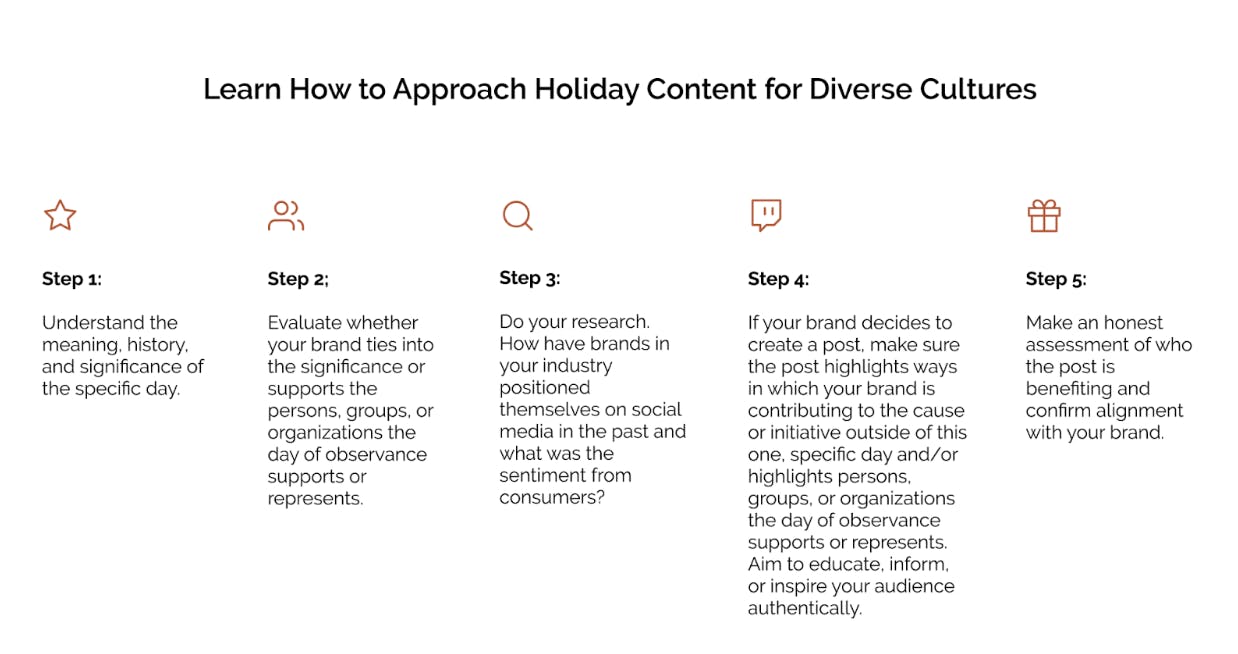.jpg?ixlib=gatsbyFP&auto=compress%2Cformat&fit=max&rect=417%2C0%2C1668%2C1668&w=392&h=146)
Overview
Social audiences continue to demand inclusion and support for diverse communities from their chosen brands, making 2022 the year for brand conversations surrounding cultural topics. It is important to remember that above all, a brand’s participation in these conversations must not only be sincere and genuine, but must provide tangible evidence of community support before engaging in conversation online. In addition, simple snippets of content on these holidays – such as an image with an overlay quote – can be read as disingenuous.
Audiences want to see the actualized, ongoing impact made by the brands that claim to support diverse communities, supplemented by meaningful and honest dialogue online. Many consumer brands are beginning to show their support of multicultural holidays and observances, but they must ensure that their contributions are authentic, non promotional, and have lasting meaning.

Rising Expectations
Social media users are demanding more from both their chosen brands and from new brands they are considering; The ability to promote diversity and inclusion from a place of authenticity is vital to a brand’s success. Projecting an image across social media needs to be met with proud evidence of a brand’s commitment to fostering inclusivity for employees and consumers offline. As younger generations continue to push brands to be more intentional with their values and support, brands should listen to their audience and adopt strategies to align with their values.
In the world of social media, it is important to remember that cultural holidays and days of remembrance are not trends for brands to capitalize on; They are days of significance that give brands the opportunity to voice their support publicly, and to showcase their offline efforts to support the cause. Brands should look for ways to raise the voices of others and highlight the people and organizations that the holiday represents/supports, such as working directly with an influencer or organization in this space (through donation or collaboration). Inserting your brand into any communication on social media without active participation in the community could receive backlash and potentially result in losing both loyal and potential customers. However, be mindful that when sharing your collaboration efforts or donation, the focus should still be on the cause or initiative and not on your donation or involvement.
BCV POV
At the end of the day, determine who will actually benefit from your post – if your first answer is not the group or organization the holiday/day of observance represents or supports, silence is key.
While silence can sometimes be viewed in a negative manner, it is better to be silent until your brand has deliberated on how to participate in actionable initiatives ahead of your social post. Keep a pulse on conversations and sentiments across all industries when events occur – whether global or community specific – to help inform your next steps.
Proactive Content Recommendation
BCV recommends that brands only post content surrounding these holidays and days of recognition if they have a localized initiative that supports the community, which ties into a more evergreen community-driven approach; This could look like highlighting an organized day or act of service in the community, or a direct brand tie-in with creators in a specific space or demographic.
Engagement Best Practices:
- Do not post just to post. Content should reflect brand efforts on a larger scale and be legally approved by brand.
- Do not post content that is unrelated to the holiday/day of observance on the specific day, as it may appear off-key and take up space within the social conversation.
- Do not repost any content specific to the holiday/day of observance from other accounts; Shared content should be created natively to drive authentic messaging.
- Include a statement – or note localized efforts – to connect to the day’s purpose if corporate or branded content is created and shared.
How to Approach
Step 1: Understand the meaning, history, and significance of the specific day.
Step 2: Evaluate whether your brand ties into the significance or supports the persons, groups, or organizations the day of observance supports or represents.
Step 3: Do your research. How have brands in your industry positioned themselves on social media in the past and what was the sentiment from consumers?
Step 4: If your brand decides to create a post, make sure the post highlights how your brand contributes to the cause or initiative outside of this one specific day and/or highlights persons, groups, or organizations the day of observance supports or represents. Aim to educate, inform, or inspire your audience authentically.
Step 5: Make an honest assessment of who the post is benefiting and confirm alignment with your brand.
Reactive Content Recommendation
BCV does not recommend taking part in any conversations as a response to a third party or partner, as this may seem promotional or create opportunities for backlash.
Monitoring Best Practices:
- Limit community engagement on any content posted on holidays/days of observance; take time to recognize the significance of the holiday/day of observance as opposed to placing direct vision onto a brand.
- Be mindful of any quotes within creative or post copy if content is created, as that may be licensed, and may also be considered off-key if a quote post is published without an initiative or brand tie-in.
- Keep hashtag volume minimal to allow space within the larger social conversation; we recommend one hashtag only, and to ensure the hashtag is being used in a positive or informational tone before assuming and posting.


